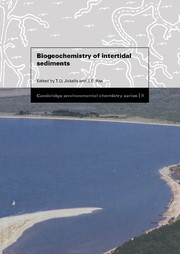Book contents
- Frontmatter
- Contents
- List of contributors
- Preface
- 1 Biogeochemistry of intertidal sediments
- 2 Trace metals in deposited intertidal sediments
- 3 Modelling adsorption and desorption processes in estuaries
- 4 A critical appraisal of the methodology used in studies of material flux between saltmarshes and coastal waters
- 5 Nutrient recycling in intertidal sediments
- 6 An overview of carbon and sulphur cycling in marine sediments
- 7 Microbial activity and diagenesis in saltmarsh sediments, North Norfolk, England
- 8 The behaviour of radionuclides in the coastal and estuarine environments of the Irish Sea
- 9 The sorption of hydrophobic pyrethroid insecticides to estuarine particles: a compilation of recent research
- Index
5 - Nutrient recycling in intertidal sediments
Published online by Cambridge University Press: 23 September 2009
- Frontmatter
- Contents
- List of contributors
- Preface
- 1 Biogeochemistry of intertidal sediments
- 2 Trace metals in deposited intertidal sediments
- 3 Modelling adsorption and desorption processes in estuaries
- 4 A critical appraisal of the methodology used in studies of material flux between saltmarshes and coastal waters
- 5 Nutrient recycling in intertidal sediments
- 6 An overview of carbon and sulphur cycling in marine sediments
- 7 Microbial activity and diagenesis in saltmarsh sediments, North Norfolk, England
- 8 The behaviour of radionuclides in the coastal and estuarine environments of the Irish Sea
- 9 The sorption of hydrophobic pyrethroid insecticides to estuarine particles: a compilation of recent research
- Index
Summary
Introduction
Intertidal sediments occupy a unique position between land and sea giving them an importance which is only now becoming apparent. Most studies have looked in detail at the nature of the biogeochemical processes (e.g. Klump & Martens, 1989) but have not had the impetus to place the processes into a quantitative context. The priority and scale of study has changed due to an awareness that intertidal areas are the front line in dealing with both the effects of climate change and the movement of materials from land to sea (Nowicki, 1994). There are now global, regional and national research programmes examining interactions at the land/sea boundary (e.g. LOICZ (Pernetta & Milliman, 1995), NECOP (Ortner & Dagg, 1995), JoNuS (Anon., 1994), LOIS (Anon., 1992)).
Concern about the impact of nutrients on the marine environment is providing a sharp focus for some of these studies (e.g. Nowicki & Oviatt, 1990; Anon., 1994). Intertidal sediments are a part of the sediment system that has long helped to maintain the productivity of the coastal zone via the storage and recycling of nutrients which were imported from offshore waters (Nixon, 1986; Nixon, 1992). Human population increases, coupled with aquatic sewerage systems and the development of intensive agriculture, have resulted in a significant change in the quantities of nutrients supplied from land sources. Now the main source of nutrients is from the land and not from the sea (Nixon, Hunt & Nowicki, 1986).
- Type
- Chapter
- Information
- Biogeochemistry of Intertidal Sediments , pp. 84 - 98Publisher: Cambridge University PressPrint publication year: 1997
- 5
- Cited by



